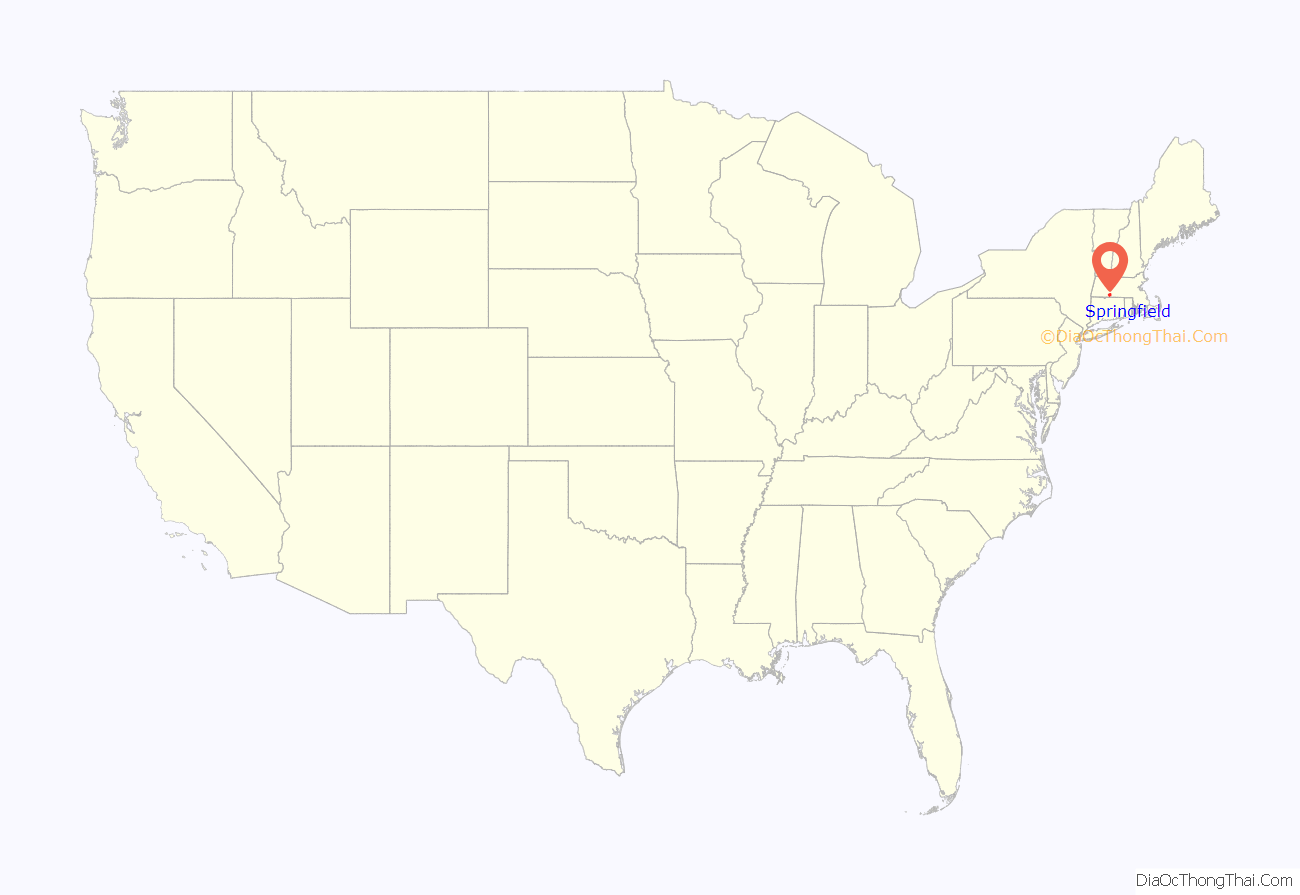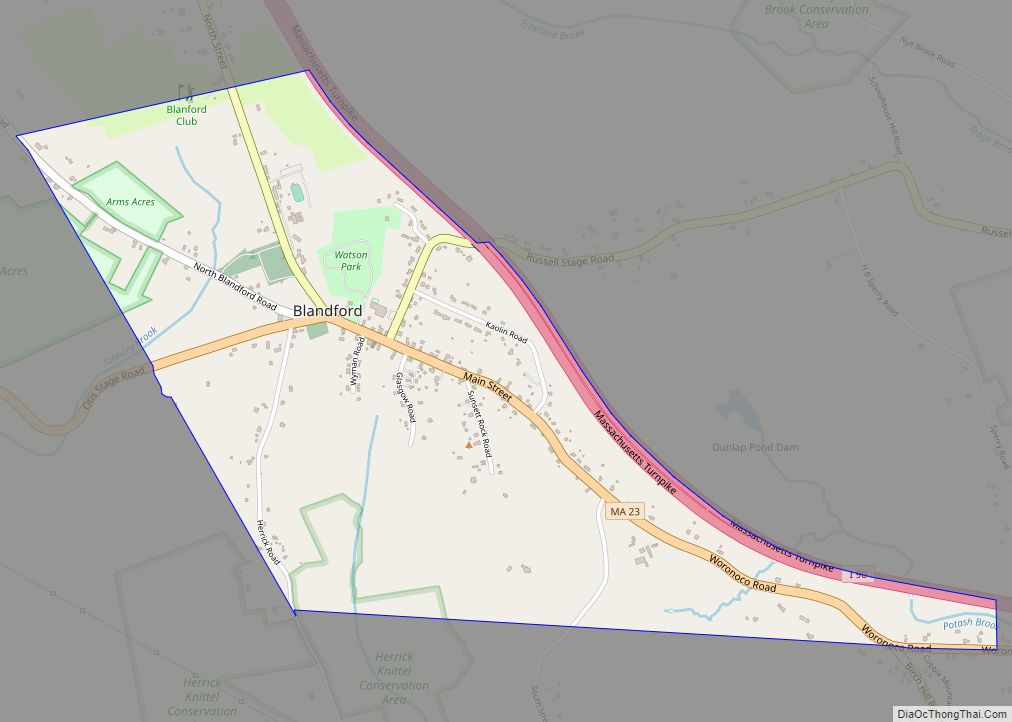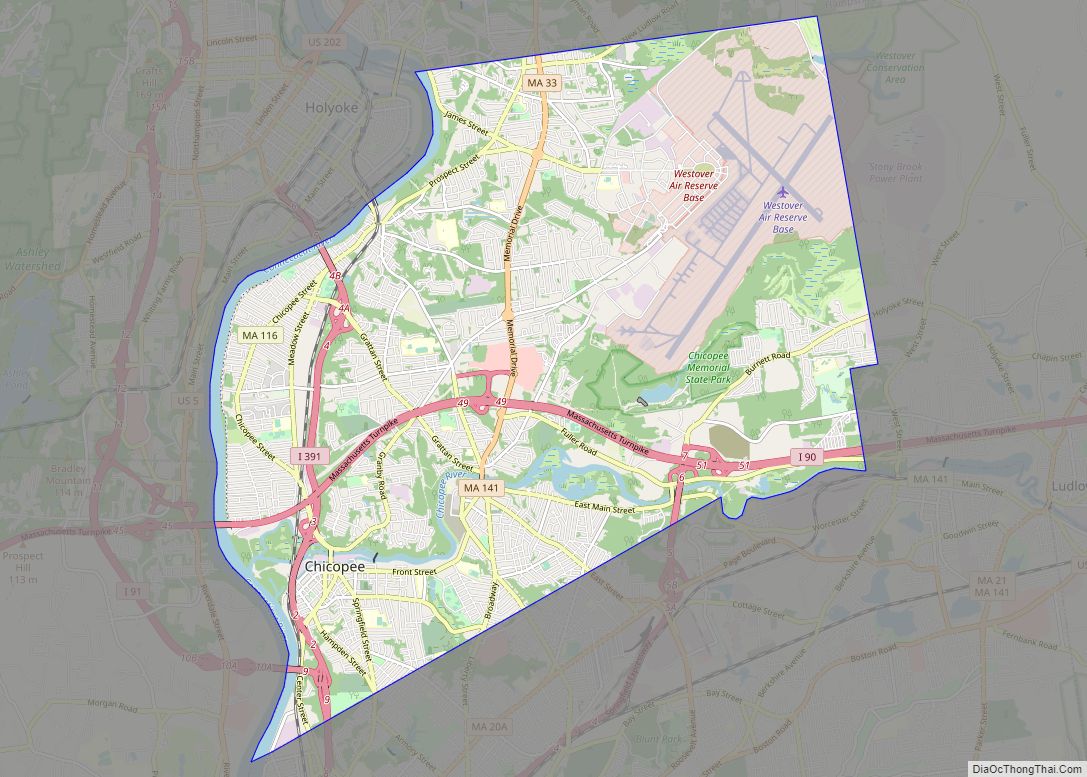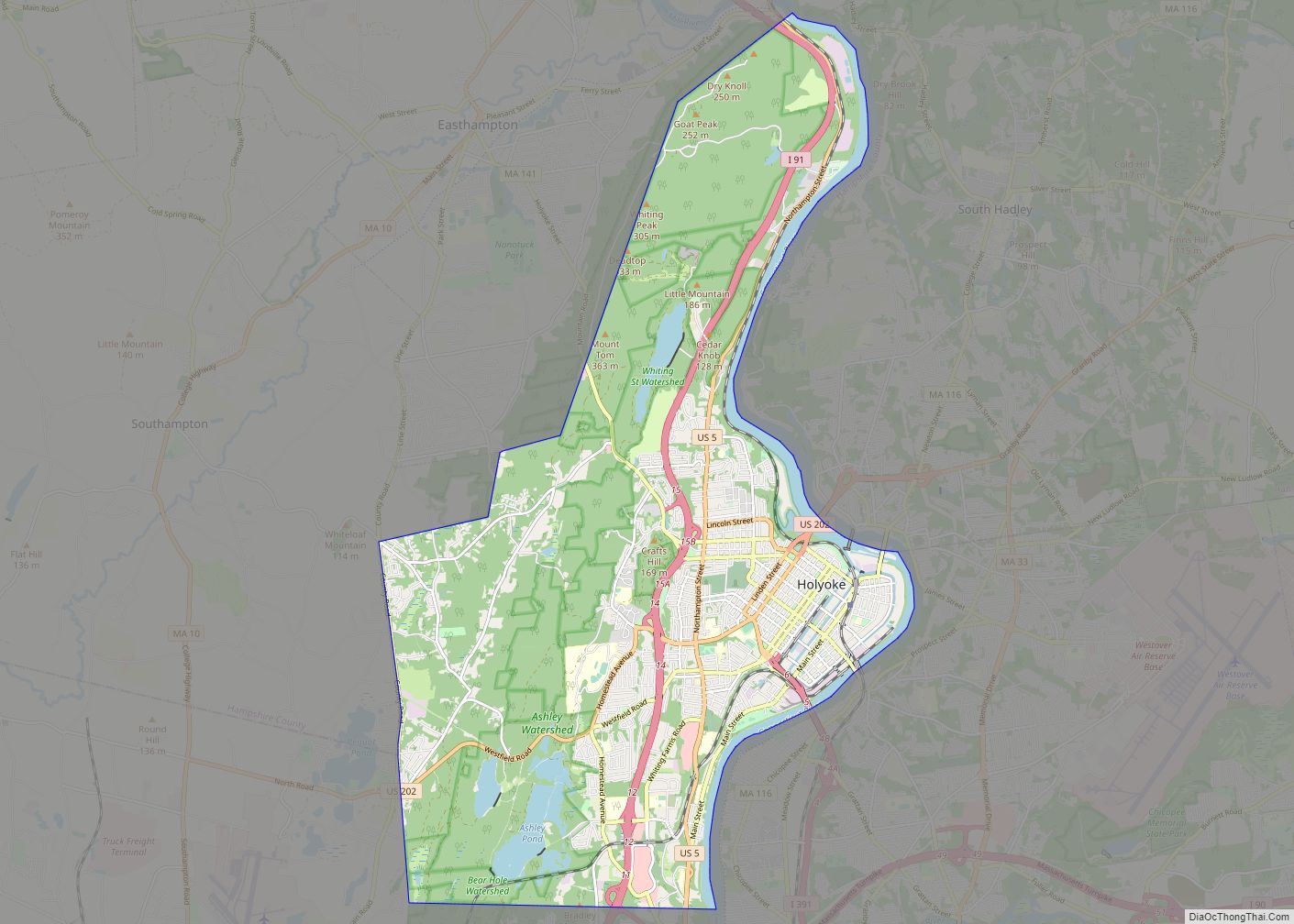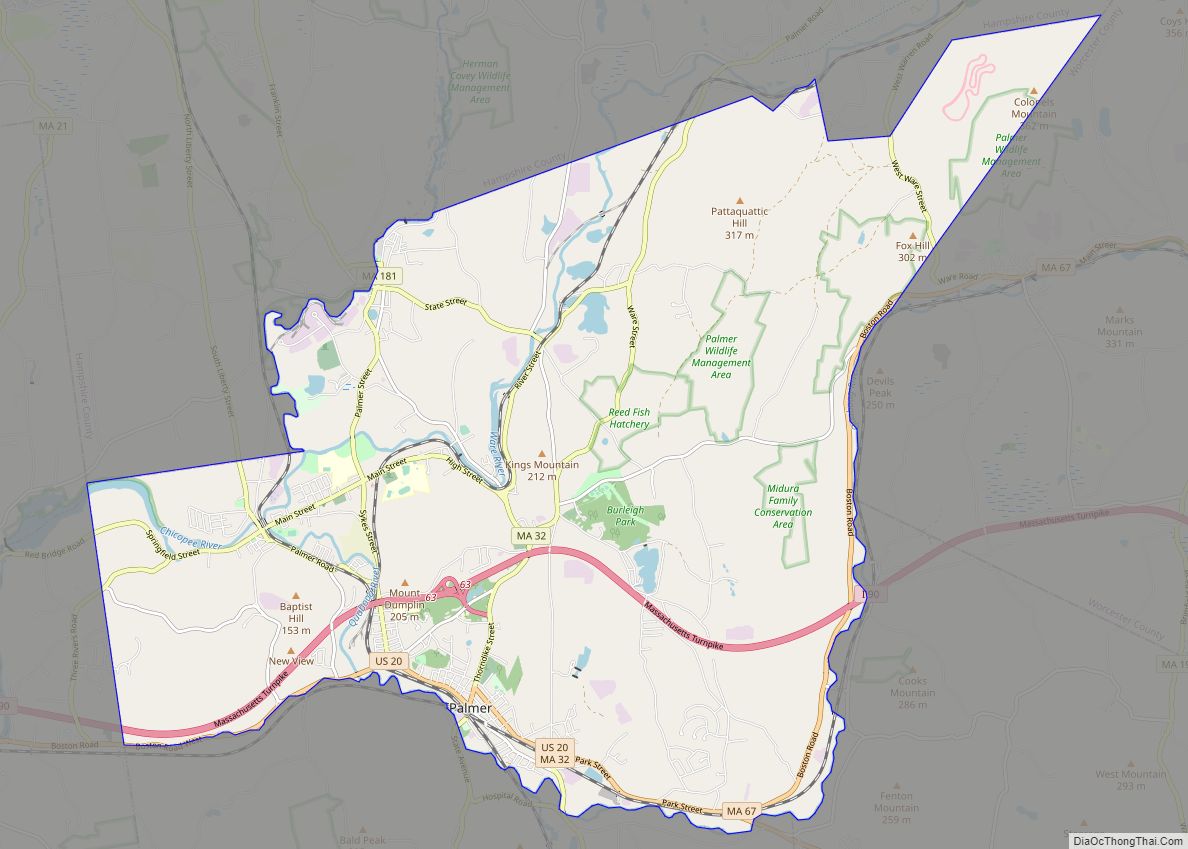Springfield is the largest city in and the seat of Hampden County, Massachusetts, United States. Springfield sits on the eastern bank of the Connecticut River near its confluence with three rivers: the western Westfield River, the eastern Chicopee River, and the eastern Mill River. At the 2020 census, the city’s population was 155,929, making it the third-largest city in the Commonwealth of Massachusetts and the fourth-most populous city in New England after Boston, Worcester, and Providence. Metropolitan Springfield, as one of two metropolitan areas in Massachusetts (the other being Greater Boston), had a population of 699,162 in 2020.
Springfield was founded in 1636, the first Springfield in the New World. In the late 1700s, during the American Revolution, Springfield was designated by George Washington as the site of the Springfield Armory because of its central location. Subsequently it was the site of Shays’ Rebellion. The city would also play a pivotal role in the Civil War, as a stop on the Underground Railroad and home of abolitionist John Brown, widely known for his raid on Harpers Ferry, and for the Armory’s manufacture of the famed “Springfield rifles” used ubiquitously by Union troops. Closing during the Johnson administration, today the national park site features the largest collection of historic American firearms in the world.
Today the city is the largest in western New England, and the urban, economic, and media capital of Massachusetts’ section of the Connecticut River Valley, colloquially known as the Pioneer Valley. Springfield has several nicknames—”The City of Firsts”, due to the many innovations developed there, such as the first American dictionary, the first American gas-powered automobile, and the first machining lathe for interchangeable parts; “The City of Homes”, due to its Victorian residential architecture; and “Hoop City”, as basketball was invented in Springfield in 1891 by Canadian James Naismith.
Hartford, the capital of Connecticut, lies 24 miles (39 km) south of Springfield, on the western bank of the Connecticut River. The Hartford–Springfield region is known as the Knowledge Corridor because it hosts over 160,000 university students and over 32 universities and liberal arts colleges—the second-highest concentration of higher-learning institutions in the United States. The city of Springfield itself is home to Springfield College, Western New England University, American International College, and Springfield Technical Community College, among other higher educational institutions.
| Name: | Springfield city |
|---|---|
| LSAD Code: | 25 |
| LSAD Description: | city (suffix) |
| State: | Massachusetts |
| County: | Hampden County |
| Elevation: | 70 ft (21 m) |
| Land Area: | 31.87 sq mi (82.54 km²) |
| Water Area: | 1.21 sq mi (3.14 km²) |
| Population Density: | 4,892.66/sq mi (1,889.08/km²) |
| Area code: | 413 |
| FIPS code: | 2567000 |
| GNISfeature ID: | 0609092 |
| Website: | www.springfield-ma.gov |
Online Interactive Map
Click on ![]() to view map in "full screen" mode.
to view map in "full screen" mode.
Springfield location map. Where is Springfield city?
History
Springfield was founded in 1636 by English Puritan William Pynchon as “Agawam Plantation” under the administration of the Connecticut Colony. In 1641 it was renamed after Pynchon’s hometown of Springfield, Essex, England, following incidents, including trade disputes as well as Captain John Mason’s hostilities toward native tribes, which precipitated the settlement’s joining the Massachusetts Bay Colony. During its early existence, Springfield flourished both as an agricultural settlement and as a trading post, although its prosperity waned dramatically during (and after) King Philip’s War in 1675, when natives laid siege to it and burned it to the ground as part of the ongoing campaign. During that attack, three-quarters of the original settlement was burned to the ground, with many of Springfield’s residents survived by taking refuge in John Pynchon’s brick house, the “Old Fort”, the first such house to be built in the Connecticut River Valley. Out of the siege, Miles Morgan and his sons were lauded as heroes; as one of the few homesteads to survive the attack, alerting troops in Hadley, as well as Toto, often referred to as the “Windsor Indian” who, running 20 miles from Windsor, Connecticut, to the settlement, was able to give advance warning of the attack.
The original settlement—today’s downtown Springfield—was located atop bluffs at the confluence of four rivers, at the nexus of trade routes to Boston, Albany, New York City, and Montreal, and with some of the northeastern United States’ most fertile soil. In 1777, Springfield’s location at numerous crossroads led George Washington and Henry Knox to establish the United States’ National Armory at Springfield, which produced the first American musket in 1794, and later the famous Springfield rifle. From 1777 until its closing during the Vietnam War, the Springfield Armory attracted skilled laborers to Springfield, making it the United States’ longtime center for precision manufacturing. The near-capture of the armory during Shays’ Rebellion of 1787 led directly to the formation of the U.S. Constitutional Convention.
During the 19th and 20th centuries, Springfielders produced many innovations, including the first American-English dictionary (1805, Merriam-Webster); the first use of interchangeable parts and the assembly line in manufacturing (1819, Thomas Blanchard); the first American horseless car (1825, Thomas Blanchard); the mass production of vulcanized rubber (1844, Charles Goodyear); the first American gasoline-powered car (1893, Duryea Brothers); the first successful motorcycle company (1901, “Indian”); one of America’s first commercial radio stations (1921, WBZ, broadcast from the Hotel Kimball); and most famously, the world’s second-most-popular sport, basketball (1891, Dr. James Naismith). Springfield would play major roles in machine production, initially driven by the arms industry of the Armory, as well as from private companies such as Smith & Wesson, established by Horace Smith and Daniel B. Wesson. Similarly, the industrial economy led Thomas and Charles Wason to establish the Wason Manufacturing Company, which produced the first manufactured sleeping car. The largest railcar works in New England, Wason produced 100 cars a day at its peak; the company was eventually was purchased by Brill in 1907 and closed during the Depression in 1937. Among numerous other industries, during the first half of the 20th century Springfield also produced brass goods, chemicals, clothing and knit goods, paper goods, watches, boilers, engines, manufacturing machinery, silverware, jewelry, skates, carriages, buttons, needles, toys, and printed books and magazines.
Springfield underwent a protracted decline during the second half of the 20th century, due largely to the decommissioning of the Springfield Armory in 1969; poor city planning decisions, such as the location of the elevated I-91 along the city’s Connecticut River front; and overall decline of industry throughout the northeastern United States. During the 1980s and 1990s, Springfield developed a national reputation for crime, political corruption, and cronyism. During the early 21st century, Springfield saw long-term revitalization projects and several large projects, including the $1 billion New Haven–Hartford–Springfield intercity rail; a $1 billion MGM casino.
Springfield Road Map
Springfield city Satellite Map
Geography
According to the United States Census Bureau, the city has a total area of 33.1 square miles (85.7 km), of which 31.9 square miles (82.5 km) are land and 1.2 square miles (3.1 km), or 3.65%, are water. Once nicknamed “The City in a Forest”, Springfield features over 4.0 square miles (10.4 km) of urban parkland, 12% of its total land area.
Located in the fertile Connecticut River Valley, surrounded by mountains, bluffs, and rolling hills in all cardinal directions, Springfield sits on the eastern bank of the Connecticut River, near its confluence with two major tributary rivers—the western Westfield River, which flows into the Connecticut opposite Springfield’s South End Bridge; and the eastern Chicopee River, which flows into the Connecticut less than 0.5 mi (0.8 km) north of Springfield, in the city of Chicopee (which constituted one of Springfield’s most populous neighborhoods until it separated and became an independent municipality in 1852). The Connecticut state line is only 4 miles (6 km) south of Springfield, beside the wealthy suburb of Longmeadow, which itself separated from Springfield in 1783.
Springfield’s densely urban Metro Center district surrounding Main Street is relatively flat, and follows the north–south trajectory of the Connecticut River; however, as one moves eastward, the city becomes increasingly hilly.
Aside from its rivers, Springfield’s second most prominent topographical feature is the city’s 735-acre (297 ha) Forest Park. Forest Park lies in the southwestern corner of the city, surrounded by Springfield’s attractive garden districts, Forest Park and Forest Park Heights, which feature over 600 Victorian Painted Lady mansions. Forest Park also borders Western Massachusetts’ most affluent town, Longmeadow. Springfield shares borders with other well-heeled suburbs such as East Longmeadow, Wilbraham, Ludlow and the de-industrializing city of Chicopee. The small cities of Agawam and West Springfield lie less than a mile (1.6 km) from Springfield’s Metro Center, across the Connecticut River.
The City of Springfield also owns the Springfield Country Club, located in the autonomous city of West Springfield, which separated from Springfield in 1774.
Climate
Springfield, like other cities in southern New England, has a hot-summer humid continental climate (Köppen: Dfa) with four distinct seasons and precipitation evenly distributed throughout the year, but the intensity (and sometimes the duration) of warmer periods greater than northern areas. Winters are cold with a daily average in January of around 26 °F (−3 °C). During winter, nor’easter storms can drop significant snowfalls on Springfield and the Connecticut River Valley. Temperatures below 0 °F (−18 °C) can occur each year, though the area does not experience the high snowfall amounts and blustery wind averages of nearby cities such as Worcester, Massachusetts, and Albany, New York.
Springfield’s summers are very warm and sometimes humid. During summer, several times per month, on hot days afternoon thunderstorms will develop when unstable warm air collides with approaching cold fronts. The daily average in July is around 74 °F (23 °C). Usually several days during the summer exceed 90 °F (32 °C), constituting a “heat wave”. Spring and fall temperatures are usually pleasant, with mild days and crisp, cool nights. Precipitation averages 45.85 inches (1,165 mm) annually, and snowfall averages 40.5 inches (103 cm), most of which falls from mid-December to early March. Although not unheard of, extreme weather events like hurricanes and tornadoes occur infrequently in Springfield compared with other areas in the country. On the occasions that hurricanes have hit New England, Springfield’s inland, upriver location has caused its damages to be considerably less than shoreline cities like New Haven, Connecticut, and Providence, Rhode Island.
On June 1, 2011, Springfield was directly struck by the second-largest tornado ever to hit Massachusetts. With wind speeds exceeding 160 mph (257 km/h), the tornado left three dead, hundreds injured, and over 500 homeless in the city alone. The tornado caused hundreds of millions of dollars worth of damage to Springfield and destroyed nearly everything in a 39-mile-long (63 km) path from Westfield to Charlton, Massachusetts. It was the first deadly tornado to strike Massachusetts since May 29, 1995.
Neighborhoods
Neighborhoods of Springfield, Massachusetts
Springfield is divided into 17 distinct neighborhoods; in alphabetical order, they are:
- Bay: features Blunt Park. In terms of demographics, Bay is primarily African American.
- Boston Road: named for its proximity to the original Boston Post Road system, features the Eastfield Mall. Primarily commercial in character, it comprises several shopping plazas designed for automobile travel.
- Brightwood: features numerous Baystate Health specialty buildings. Amputated from the rest of Springfield by the Interstate 91 elevated highway, academic suggestions are being made to reunite the neighborhood with the city.
- East Forest Park: Primarily middle class residential in character. Borders East Longmeadow, Massachusetts.
- East Springfield: features Smith & Wesson and the Performance Food Group. Residential and working-class in character.
- Forest Park: features 735 acres (3.0 km) Forest Park and the Forest Park Heights Historic District, (established 1975). Residential in character, featuring a commercial district at “The X” and an upper-class garden district surrounding Forest Park.
- Indian Orchard: features a well-defined Main Street and historic mill buildings that have become artists’ spaces. Formerly a suburb of Springfield, Indian Orchard developed separately as a milltown on the Chicopee River before joining Springfield. Primarily residential in character, Indian Orchard features Lake Lorraine State Park, Hubbard Park, and weekly farmers markets.
- Liberty Heights: features Springfield’s three nationally ranked hospitals: Baystate Health, Mercy Medical, and Shriner’s Children’s Hospital. Primarily residential and medical in character, it features a demographically diverse population. Liberty Heights includes eclectic districts like Hungry Hill and Atwater Park, and Springfield’s 3rd largest park, Van Horn Park.
- The McKnight Historic District: features the Knowledge Corridor’s largest array of historic, Victorian architecture, including over 900 Painted Ladies. Primarily residential in character, McKnight was the United States’ first planned residential neighborhood. McKnight’s commercial district is called Mason Square. Features American International College. In terms of demographics, McKnight features significant populations of African American and LGBT residents, and is home to Mason Square, named for African American philanthropist Primus P. Mason.
- Memorial Square: features the North End’s commercial district.
- Metro Center: features nearly all major cultural venues in the region. Commercial, cultural, civic, and increasingly residential in character. Features the Downtown Business District, The Club Quarter—with more than 60 clubs, restaurants, and bars—numerous festivals, cultural institutions, educational institutions, and significant historic sites.
- North End: not technically a Springfield neighborhood, but rather three northern Springfield neighborhoods. Includes Brightwood, which is residential and medical in character, but cut off from the rest of the city by Interstate 91; Memorial Square, which is commercial in character; and Liberty Heights, which is medical and residential in character. In terms of demographics, the North End is predominantly Puerto Rican.
- Old Hill: features Springfield College. Residential in character. Bordering Lake Massasoit. Old Hill is primarily Latino.
- Pine Point: features the headquarters of MassMutual, a Fortune 100 company. Primarily middle-class and residential in character.
- Six Corners: features Mulberry Street in the Ridgewood Historic District (established 1977); the Lower Maple Historic District (established 1977); and the Maple Hill Historic District, (established 1977). Urban and residential in character.
- Sixteen Acres: features Western New England University and SABIS International School. Suburban in character. Includes much of Springfield’s post-World War II suburban architecture.
- South End: features numerous Italian–American restaurants, festivals, and landmarks. Urban and commercial in character, this neighborhood was hard hit by the June 1, 2011, tornado. Includes the Naismith Memorial Basketball Hall of Fame; however, it is separated from it by Interstate 91.
- Upper Hill: features Wesson Park. Bordering Lake Massasoit. Residential in character. Located between Springfield College and American International College.
See also
Map of Massachusetts State and its subdivision: Map of other states:- Alabama
- Alaska
- Arizona
- Arkansas
- California
- Colorado
- Connecticut
- Delaware
- District of Columbia
- Florida
- Georgia
- Hawaii
- Idaho
- Illinois
- Indiana
- Iowa
- Kansas
- Kentucky
- Louisiana
- Maine
- Maryland
- Massachusetts
- Michigan
- Minnesota
- Mississippi
- Missouri
- Montana
- Nebraska
- Nevada
- New Hampshire
- New Jersey
- New Mexico
- New York
- North Carolina
- North Dakota
- Ohio
- Oklahoma
- Oregon
- Pennsylvania
- Rhode Island
- South Carolina
- South Dakota
- Tennessee
- Texas
- Utah
- Vermont
- Virginia
- Washington
- West Virginia
- Wisconsin
- Wyoming
